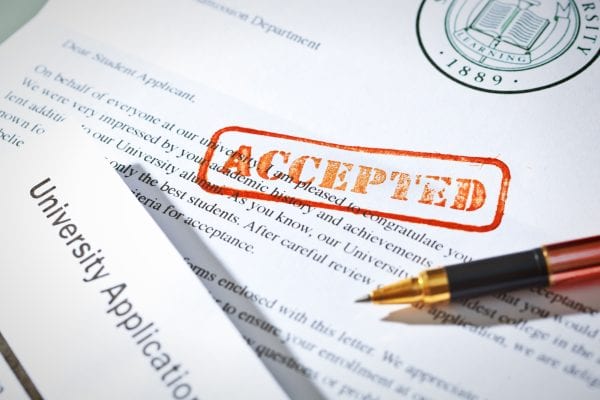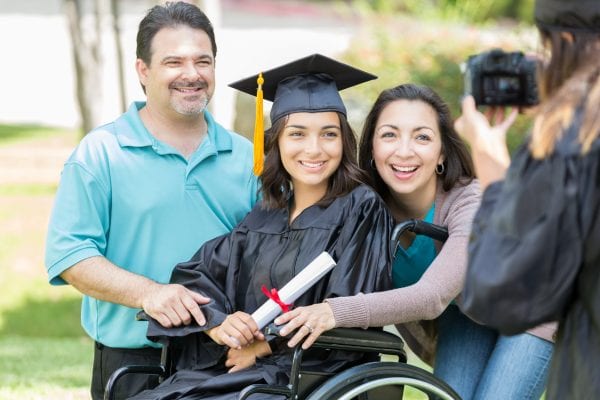Finance & Career

Access to education beyond high school is important for all young people. Many communities in the state of Alabama have jobs that require postsecondary education.
Postsecondary means education after high school. Graduating from postsecondary institutions, such as trade schools or 2- or 4-year colleges, will strengthen the ability of young people to earn more money to help their families and communities. As shown in table 1, a person who continues his or her education after high school will likely make more money compared to a high school graduate and will be less likely to experience job loss. Salary rates will vary based on the state in which you live.
Some students may believe that education beyond high school only means going to college. For students who do not want to go to college, completing a professional certificate in a job-specific program would be a better option. Vocational and trade schools offer specific career training such as cosmetology and medical assistant. Table 2 shows the average income for various careers that require a professional certificate.
Table 1: Salary Comparisons Based on Level of Education
Source: U.S. Bureau of Labor Statistics (2017)
| Weekly Median Earnings | Job Loss Rate % |
|---|---|
| High School Graduate (Including GED) $712 | 4.6% |
| Some College (No Degree) $774 | 4% |
| Associate Degree (2-year College) $836 | 3.4% |
| Bachelor’s Degree (4-year College) $1,173 | 2.5% |
| Master’s Degree $1,401 | 2.2% |
| Professional Degree $1,836 | 1.5% |
Table 2: Annual Salaries of Labor and Service Careers
Sources: U.S. Department of Labor, Bureau of Labor Statistics (2018)
| Job Title | Annual Earnings |
|---|---|
| Barber/Cosmetologist | $24,830 |
| Electrician | $55,190 |
| Elevator Installer and Repairer | $79,780 |
| Home Entertainment Installer and Repairer | $38,160 |
| Medical Assistant | $33,610 |
| Medical Records Technician | $40,350 |
| Photographer | $34,000 |
| Plumbing/Air-Conditioning Contractor | $53,910 |
| Railroad Conductor and Yard Master | $66,080 |
| Skin Care Specialist | $31,290 |
Types of Financial Assistance
The cost of tuition for education beyond high school is rising faster than the financial resources of most students and their families. Without financial assistance, most students will not be able to further their education after graduating from high school. Various types of financial assistance, such as fellowships, grants, and scholarships. are available to help students who live in Alabama and who want to obtain education beyond high school. Fellowships, grants, and scholarships are types of financial assistance that do not have to be repaid. While educational loans are provided through funding from institutions such as banks and state higher education lending sources, students are expected to repay the loan at an agreed-upon interest rate. Loan repayment typically begins six months after the student graduates.
In addition, Alabama in-state reduced tuition rates are available for most public state colleges and universities. There is a specific requirement, however, for future students to be a resident for at least 12 months. Families may want to consider relocation one to two years before applying. Check with the Alabama legislature for specific rules. For more information, contact the financial aid office at the university to which you intend to apply and ask for more details regarding residency for the purpose of tuition.
Calculating the Cost of Postsecondary Education
 As parents and students consider options for obtaining education beyond high school, many become discouraged when they consider the cost of postsecondary tuition. Parents and students often overestimate the cost because the majority of students do not pay the total price. This means that, when the cost of postsecondary education is being considered, parents and students need to deduct financial assistance, such as grants, scholarships, and fellowships (money that does not have to be repaid), from the total tuition price. For example, if the total cost of attending a university is $10,000 per semester and a student will receive $6,000 in financial assistance, then the actual cost for the student’s education would be $4,000 per semester. Students should also look at the average student loan debt of the postsecondary schools of interest. Table 3 provides the rank of average student loan debt for postsecondary institutions in Alabama.
As parents and students consider options for obtaining education beyond high school, many become discouraged when they consider the cost of postsecondary tuition. Parents and students often overestimate the cost because the majority of students do not pay the total price. This means that, when the cost of postsecondary education is being considered, parents and students need to deduct financial assistance, such as grants, scholarships, and fellowships (money that does not have to be repaid), from the total tuition price. For example, if the total cost of attending a university is $10,000 per semester and a student will receive $6,000 in financial assistance, then the actual cost for the student’s education would be $4,000 per semester. Students should also look at the average student loan debt of the postsecondary schools of interest. Table 3 provides the rank of average student loan debt for postsecondary institutions in Alabama.
Keep in mind that financial aid forms can be confusing. If you need assistance completing the form, contact the financial aid office of the school to which your are applying. Some schools schedule specific dates and times for students to meet with counselors for help completing forms. Some high school guidance counselors may also provide assistance completing forms and getting financial assistance.
Table 3: Rank of Average Alabama Student Loan Debt per Graduate
| Rank | School Name | Avg Debt Per Grad | % of Grads w/ Debt |
|---|---|---|---|
| 1 | Samford University | $10,545 | 36% |
| 2 | Auburn University | $11,550 | 41% |
| 3 | University of Alabama | $15,89 | 47% |
| 4 | University of Montevallo | $17,886 | 62% |
| 5 | University of Mobile | $18,318 | 61% |
| 6 | University of West Alabama | $18,581 | 76% |
| 7 | University of Alabama, Huntsville | $18,905 | 54% |
| 8 | Auburn University at Montgomery | $21,013 | 69% |
| 9 | University of Alabama, Birmingham | $22,019 | 63% |
| 10 | Tuskegee University | $24,380 | 92% |
| 11 | Faulkner University | $25,810 | 89% |
| 12 | Huntingdon College | $27,13 | 81% |
| 13 | Alabama State University | $27,614 | 85% |
| 14 | Stillman College | $29,212 | 96% |
Career Selection and Education Cost
 The type of career you select, as well as other things related to career choice, can affect how much your college education will cost. When choosing among various types of careers, the student needs to look at the cost of an education. The average level of educational debt for college graduates in Alabama is about $15,901, which may threaten the financial well-being of many graduates. Many college graduates find that their loan payments are so large that they must delay large purchases, such as a new car or a house.
The type of career you select, as well as other things related to career choice, can affect how much your college education will cost. When choosing among various types of careers, the student needs to look at the cost of an education. The average level of educational debt for college graduates in Alabama is about $15,901, which may threaten the financial well-being of many graduates. Many college graduates find that their loan payments are so large that they must delay large purchases, such as a new car or a house.
A good example of this is the decision to become a teacher. Teachers earn much less than they should, considering their high value to society, so debt relief is a necessity to attract good teachers. Under the College Cost Reduction and Access Act of 2007, Section 104, the Teacher Education Assistance for College and Higher Education (TEACH) grant program provides up to $4,000 a year in grant aid to undergraduate and graduate students and those enrolled in a post-baccalaureate teacher credential program.
To qualify for a TEACH grant, students are required to work as full-time teachers for a minimum of four years. Students must complete their service to the TEACH grant within eight years of obtaining an education degree. In addition, students must agree to teach in areas such as math, science, foreign languages, special education, developmental reading, or a subject designated as high need by the federal or state government or by a local education agency. The chief administrator of the student’s place of employment must provide the National Association of Student Financial Aid Administrators proof of grant compliance each school year.
If you do not meet your TEACH obligation, your grant will be changed to a Direct Unsubsidized Loan. With an unsubsidized loan, the student is responsible for the money borrowed and interest owed. However, a subsidized loan means that the government pays the interest while the student is in school, during an economic hardship such as unemployment, or in active military duty. The school you attend sets the amount you can borrow for both types of loans.
Another teacher-specific program is the Teacher Loan Forgiveness Program. Once a person has taught for five years in a row in certain schools or educational agencies, he or she can qualify for up to $17,500 of loan forgiveness for certain types of loans. Additionally, teachers serving in low-income schools, special education, or in a subject shortage area can apply for complete loan cancellation (discharge) of Federal Perkins Loans.
People who choose to work in public service field job such as a teacher or public defender, can qualify for Public Service Loan Forgiveness. Participants must have a qualifying repayment plan and can apply for loan forgiveness after making 120 payments toward loans. Another option is income-driven repayment plans for federal student loans. To be eligible the applicant’s student loan debt must be higher than his or her annual income or be a significant portion of his or her annual income.

In addition, individuals who decide to teach may want to consider teaching specific courses related to science, technology, engineering, and mathematics (STEM). Many states, including Alabama, are providing loan reimbursement for tuition paid for undergraduate courses through the Teacher Loan Forgiveness Program.
Nurses can also qualify for loan repayment programs through Nurse Corps by working full time in facilities such as public and educational hospitals and long-term care facilities. There are also Nursing Education Scholarships for Alabama residents and for students seeking a bachelor of science degree in nursing at Auburn University. Contact the University Scholarship office at (334) 844-4723 for more details.
Most loan forgiveness or cancellation programs require that the loans be federal loans rather than private educational loans. Contact the offices that administer all of the programs mentioned to find out if your loans are eligible.
Low-income Student Grants for Nonteachers
The College Cost Reduction and Access Act of 2007 also provides additional Pell Grant funding to assist low- income students in paying postsecondary educational expenses. A Pell Grant, unlike a loan, does not have to be repaid. Pell Grants are usually awarded only to undergraduate students who have not earned a bachelor’s or a professional degree. Pell Grants are considered a foundation of federal financial aid to which aid from other federal and nonfederal sources might be added.
Another source of money for which all Alabama high school and college students can qualify is the Alabama Student Assistance Program (ASAP). To qualify, you must be an Alabama resident and attending an eligible Alabama institution. ASAP is a need-based, state/federal grant ranging from $300 to $5,000 per academic year. To apply for this program, submit the Free Application for Federal Student Aid (FAFSA) to the federal government.
Graduate Debt Free or Almost Debt Free
Some colleges, such as Berea College and Alice Lloyd College, offer students free tuition. Students at institutions such as these participate in work study programs and receive a combination of financial assistance (e.g., grants, loans, and scholarships). Other schools offer needs- based scholarships that cover between 60 percent and 100 percent tuition. These include Deep Springs College, Harvard, Massachusetts Institute of Technology (MIT), and Web Institute.
Other colleges offer free tuition, but students may also be responsible for fees that include books, health services, and room and board. You might be surprised that countries such as Finland, Germany, and Norway offer free tuition to international students. Students who attend international schools will be responsible for costs such as travel, and room and board.
Organizing College Selection Materials
Regardless of the program of study, there are ways to manage school expenses and not be burdened by debt for years after completing a program. The key to managing college expenses is to prepare early. Before your junior year of high school, start exploring colleges of interest. Look for scholarships for which you may be eligible. A college selection form is available at the end of this document to help you organize college selection materials.
Special Considerations
 Students with disabilities may find special scholarships and grants. If you have a disability, contact your campus of choice, office of disability services or office of accessibility to learn more about the campus resources and steps to receiving academic accommodations. For students who have served in the military, contact your campus of choice office of veteran affairs to learn more about special scholarships such as the GI Bill and transitional and career development services. Nearly every state will offer financial assistance in the form of state grants and loans. To find out which agency in your state may offer financial assistance for higher education, visit http://www2.ed.gov/about/ contacts/state/index.html.
Students with disabilities may find special scholarships and grants. If you have a disability, contact your campus of choice, office of disability services or office of accessibility to learn more about the campus resources and steps to receiving academic accommodations. For students who have served in the military, contact your campus of choice office of veteran affairs to learn more about special scholarships such as the GI Bill and transitional and career development services. Nearly every state will offer financial assistance in the form of state grants and loans. To find out which agency in your state may offer financial assistance for higher education, visit http://www2.ed.gov/about/ contacts/state/index.html.
Avoiding College Planning Scams
Please remember that you should never pay to receive information about financial aid or scholarships. Never provide a social security number or banking information to receive college planning information.
Education Beyond High School Forms
Printable forms to help you plan for education beyond high school are available on pages 5 and 6 in the downloadable PDF of this document. See below.
Financial Resources
Diversity Student Education Resources
American Indian College Fund
- 8333 Greenwood Blvd Denver, CO 80221
- scholarships@collegefund.org or (800) 776-3863
- Website: https://collegefund.org/students/
American Indian Graduate Center
- 4520 Montgomery Boulevard, NE Suite 1-B, Albuquerque, NM 87109
- (800) 628-1920 or (505) 881-4584
Alabama Indian Affairs Commission
- 771 South Lawrence Street, Suite 106 Montgomery, AL 36130
- (334) 240-0998
- aiac@att.net
- Website: www.aiac.alabama.gov
Hispanic Scholarship Fund (HSF)
- 1411 W. 190th St., Suite 700 Gardena, CA 90248
- (310) 975-3700
Poise Foundation via National Association for the Advancement of Colored People (NAACP)
- Two Gateway Center, Suite 1700, 603 Stanwix Street Pittsburgh, PA 15222
- Phone: (412) 281-4967
The Jackie Robinson Foundation
- One Hudson Square, 75 Varick Street, 2nd Floor New York, NY 10013-1917
- Phone: (212) 290-8600
Asian and Pacific Islander Scholarship Fund
- 2025 M Street NW, Suite 610 Washington, DC 20036
- Phone: (202) 986-6892
- Toll Free: (877) 808-7032
- Email: info@apiasf.org
US Pan Asian Chamber of Commerce
- 1329 18th Street NW Washington, DC 20036
- Phone: (202) 296-5221
- Toll Free: (800) 696-7818
- info@uspaacc.com
Science Technology Engineering Mathematics (STEM) Scholarships
Buick Achievers Scholarship Program
Siemens Competition in Math, Science, and Technology
Scholarships for Women in STEM: Palantir Women in Technology Scholarship
Scholarships for Individuals with Disability:
Alabama Scholarship for Dependents of Blind Parents Alabama Department of Rehabilitation Services
- Attn: Dana Barber
- #4 Medical Office Park Talladega, AL 35160
- Phone: (256) 362-0638
Hard of Hearing and Deaf Scholarship Sertoma International
- (816) 333-8300
Anne Ford and Allegra Ford Scholarship
- National Center for Learning Disabilities
- (888) 575-7373
- Website: https://www.ncld.org/what-we-do/scholarships
William C. Stokoe Scholarship
- National Association of the Deaf: Stokoe
- (301) 587-1789 (TTY)
- (301) 587-1788 (voice)
- Website: www.nad.org
Scholarships for Future Nurses:
Alabama Board of Nursing
- P.O. Box 303900 Montgomery, AL 36130-3900
- (334) 293-5257
- (800) 656-5318
- Website: www.abn.alabama.gov/ alabama-nursing-resource-center/ grad-students/#tab-scholarships
Financial Assistance Resources:
Other sites for more information about grants, scholarships, loan forgiveness, etc.
Alabama Commission on Higher Education
- P.O. Box 302000 Montgomery, AL 36130-2000
- (334) 242-1998
Kentucky Higher Education Assistance Authority-Alabama
- www.alstudentaid.com
- 1 (800) 928-8926
Alabama GI Dependents Education Benefit Program
- Alabama Department of Veterans Affairs P.O. Box 1509, Montgomery, AL 36102-1509
- (334) 242-5077
Grants:
www.gocollege.com/financial-aid/college-grants/
Scholarships:
Student Loans/Loan Forgiveness:
studentloans.gov/myDirectLoan/index.action
Video link: www.youtube.com/watch?v=mTHtn0FRMWw
Finland:
Germany:
Norway:
www.studyinnorway.no/Study-in-Norway/Education-system
TEACH Grant:
https://studentaid.ed.gov/sa/sites/default/files/teach-grant.pdf
Katrina A. R. Akande, Extension Specialist, Assistant Professor, Family and Child Development; DaJuandra Eugene, Graduate Assistant, Human Development and Family Studies; and Katherine Corbin, Undergraduate Student, Human Development and Family Studies, all with Auburn University
Revised March 2020, Education Beyond High School Affordable for Alabama Families, FCS-2357

